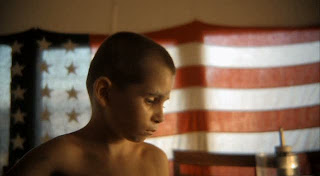If California were a country, it
would be the eight-largest economy in the world. It is the most populated U.S
state, and is the home of Hollywood. Los Angeles houses the super-rich and is
often seen as a symbol of Western glamour and decadence, San Francisco is
famous for its liberal activism, Silicon Valley is home to the world’s largest
technology corporations, and Yosemite National Park is one of the most
beautiful in the country, not to mention the world. These are important facts
to consider when you watch Alma Har’el’s stunning debut Bombay Beach which documents the inhabitants of one of California’s
most poverty stricken and desolate towns. It lies on the banks of Salton Sea, a
fetid saline lake created by an accidental flood in 1905, whose salt levels are
so great that nothing much can survive. However, a small collection of fascinating
people soldier on and live out their lives in this dystopian utopia, which the
movie documents. Har’el selects three individuals to focus on who together
represent a triptych of manhood in its decisive moments. They are bipolar 7 year-old
Benny Parish; CeeJay, an amorous high school football star; and philosophical octogenarian poet-prophet, Red.
The film’s surrealism seems
natural when capturing such a surreal place. Bombay Beach is an hour’s drive
away from Palm Springs, yet you would be forgiven in thinking it looks like a
nuclear wasteland. The visuals of Har’el’s film bore a striking resemblance to
the Fallout video games series. This
is unsurprising, considering those games take place in a fictional alternate
history where the cold-war nuclear tension of the fifties, sparked a full blown
nuclear war, and so the towns that survive are fossilised remnants of forgotten
prosperity and hopefulness, much like Salon Sea itself, which was once known as
the ‘California Riviera’.
Bombay Beach can easily be compared to Harmony Korine’s Gummo, or David Gordon Green’s George Washington, both focus on the
inhabitants of small depressed towns, with an obtuse poetical style. Yet Bombay Beach is all the more fascinating
than the other two in that it’s not a work of fiction, the fact these
characters exist and breathe in this world makes for a compelling watch. On a
final note, something ought to be said for the film’s musical quality. Every
now and then the characters break out into choreographed danced while Beirut
plays on the soundtrack. My only gripe here is the choice of music. I highly
doubt the people of Bombay Beach are regular listeners to Beirut, and when the
music plays the gentle poetical realism of the film suddenly breaks down and
the whole thing becomes (at the risk of sounding like an arsehole) a little
bourgeois. However, this is only a personal complaint, and should not detract
from what is a beautiful and captivating 80 minutes of cinema.

No comments :
Post a Comment